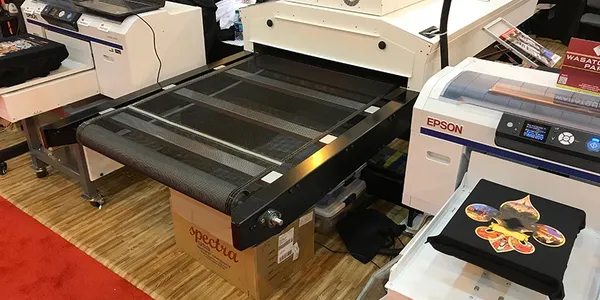
by Michael Best | Feb 1, 2024 | General interest
Last week I had a conversation with Pablo Forno of Grand Slam Sports of Okotoks, Alberta. I asked for the conversation because I’d heard that Pablo had an interesting perspective on the DTG versus screen printing debate. He had switched all his production from screen printing to direct to garment but a year later switched back a significant portion of his production to screen printing. I was interested to find out why.
Grand Slam Sports prints team uniforms in addition to regular, multi-colour prints on tees and sweats. The DTG printer is an Epson F2100 and the screen-printing press is a 4-colour, 4-station. Printing exclusively on the DTG printer wasn’t working for Pablo mainly because the garments have to be pre-treated and then racked to dry overnight. In addition to that, Pablo found that he had to heat press the garments to ensure that they were properly dry and ready for the printing.
For team uniforms that are usually polyester requiring only one or two-colour prints, he has found that it’s much quicker and more cost effective to screen print. But, the DTG printer is still used for short, multiple-colour runs.
So, if you’re considering a DTG printer you’d be well advised to consider it, not as a replacement for your screen-printing press, but rather as supplemental. And, of course, you need to have a very clear understanding of the financial impact and the cost-benefit aspect of the production balancing act you’re considering
Credit: Pablo Forno at www.grandslamcanada.com

by Michael Best | Jan 25, 2024 | Archive
There are many, many books, articles, and blog posts on how to manage staff. But sometimes you just have to be an a******. Well, at least that’s part of the management philosophy of the now ex-owner of a very big Canadian shop. I’m not going to name the shop or even the city because I haven’t specifically asked for permission to share this story. So let’s just call him Bob.
Bob is a mild-mannered, personable, considerate, unexcitable person—what most people would call an all-round decent guy. And this was reflected in his management style too. This is why when I heard this story years ago it tickled me then, and still does today.
Bob had established a designated smoking zone behind the shop for those essential smoke breaks that a number of his staff members apparently needed. He only had one rule—they had to place their cigarette butts in the provided bin. However, much to his annoyance the rule would be ignored and he’d find butts littering the ground. After repeatedly reminding the staff to use the butt bin, he apparently uncharacteristically “lost it” one day when he again found butts lying around.
He called the crowd of smokers into his office and shocked them by “going nuts.” As the saying goes, he went up one side of them and down the other. I understand that this was the end of cigarette butts on the ground. As Bob explained, “Sometimes you just have to be an a******!”

by Michael Best | Dec 18, 2023 | General interest
Let’s not kid ourselves . . . As small business owners we can’t deny that we suck at work-life balance. We grind endlessly. We don’t quit at 5.00 pm, we check emails all the time outside normal work hours, we feel guilty if we don’t “just pop in for a short while” to work at weekends, and we don’t take proper vacations, And we wear this as a badge of honour. There’s the old joke: “I own my own business so, yes, I get to choose my work hours. I get to choose which twenty out of twenty-four I’m going to work!”
The truth though is that it’s not a badge of honour and it’s not a joke; it’s a tragedy. It’s bad for our health (physical and mental), bad for family life, tough on those closest to us, and no way to live a balanced, fulfilling life. And we all know this.
So what to do about it? The first thing to realize is that it has to change. And the second thing to realize is that there’s no one-fits-all solution. But this doesn’t mean that you can delay finding a better work-life balance. What constitutes the right work-life balance will vary over time and have to be adjusted according to prevailing circumstances. So, it’s a work in progress. But “work in progress” is the key. It’s both something to work at and something that should always be in progress. If not, you will lapse back into choosing which twenty-two out of twenty-four hours you’re going to grind and your work-life balance will again be thrown out of whack.
if you have 9 minutes to spare for a humorous take on grinding at work, watch this Pardis Parker Ted talk.
Get off the treadmill and reconsider your work-life balance before it’s too late.

by Michael Best | Dec 14, 2023 | General interest
T-shirts are perfect for sampling. But there’s an effective way and a less-than-effective way to sample.
The purpose in sampling is to show off the product with the intention of provoking a sale. And the more the act of sampling and the nature and quality of the product excites and intrigues the recipient, the more likely it is to provoke a sale.
First, the less-than-effective way to sample . . . If you’re going to drop off a sample garment with no explanation and no follow up, don’t hold your breath waiting for results—they’re not coming.
So here, based on my own experience and that of others with whom I’ve discussed sampling, is what I’d suggest . . . be selective about whom you’re going to sample, that is, qualify them. Then take a page out of Apple’s book and package the sample spectacularly in a way that demonstrates your caring and creativity. The garment(s) should speak to your creative design talents and superb printing quality. I think you know what I mean—wow the recipient.
Just by handing over a sample packaged more like a special gift than a run-of-the-mill commercial sample, will charm the recipient and give you a much better chance of creating a favourable impression. A card with a short, appropriate note explaining that this is a sample of what you can do, will add to the effectiveness of the presentation. Finally, you must follow up to ask if the recipient has any questions and also to keep the contact going.
Sampling with care and charm is an inexpensive yet effective way of making and consolidating contacts, creating a good impression, and generating good vibes. And, as we all know, people prefer to do business with people they like .

by Michael Best | Dec 11, 2023 | General interest
Real life stories are a great way to make a point. And the point I want to make (yet again) with this story is that if small businesses don’t match big businesses in certain aspects, it will undermine their growth and survival prospects.
Of course, there are aspects to small businesses that differentiate them favourably from big businesses, but the one where so many of them fall down, is prompt and efficient service. Let me tell my story and you’ll see what I mean.
I support independent bookstores whenever I can; my favourite is in Lunenburg. So, when I recently received their monthly newsletter and spotted a book that would be ideal for my ten-year-old granddaughter, I emailed one of the owners that I know well to ask if they had it in stock and whether they would reserve a copy for me. Notwithstanding the fact that Lunenburg (home of the Bluenose II) is always a wonderful place to visit, I didn’t want to drive forty kilometers only to find that they were sold out.
When, after three or four hours, I hadn’t heard back, I called the store. By now it was during business hours but nobody answered the phone. A message eventually kicked in and suggested that I email the store, which I promptly did after finding the email address on their website. But then, out of curiosity, I logged onto Amazon.ca and found the book there for $14.95, with free delivery courtesy of Prime. I was tempted to order it right away but I decided that regardless of how I felt about the difficulty rousing anyone at my favourite bookstore, I’d still rather give them the business—I figured Jeff Bezos doesn’t really need it.
It’s been thirty-six hours now and I haven’t had a return call or an email. A less loyal customer would by now have ordered the book from Amazon and moved on. Who could blame them, especially when they’d also be saving the $14.00 or so that Canada Post would want for delivering the book to Ontario?
And therein lies my point . . . . If small businesses are to succeed in a competitive market, they need to make sure that they match big business in prompt and efficient service. Trading on customer loyalty and a sentimental preference for supporting small local businesses, has its limitations.





